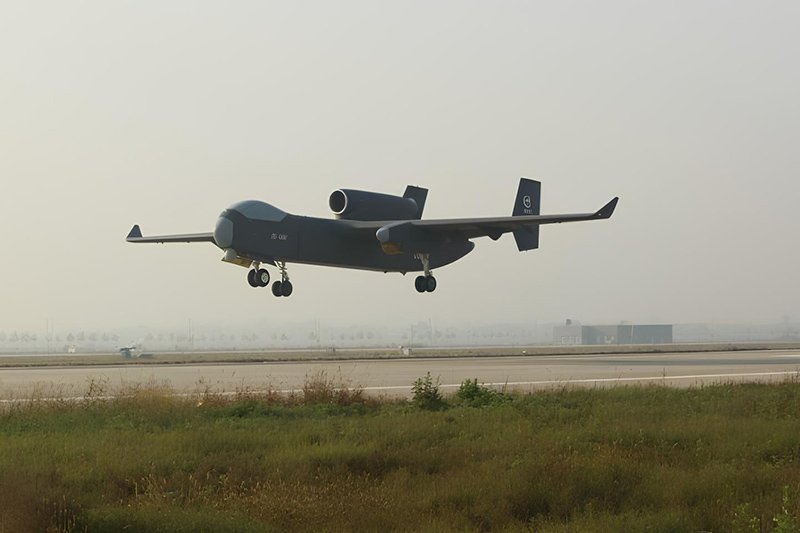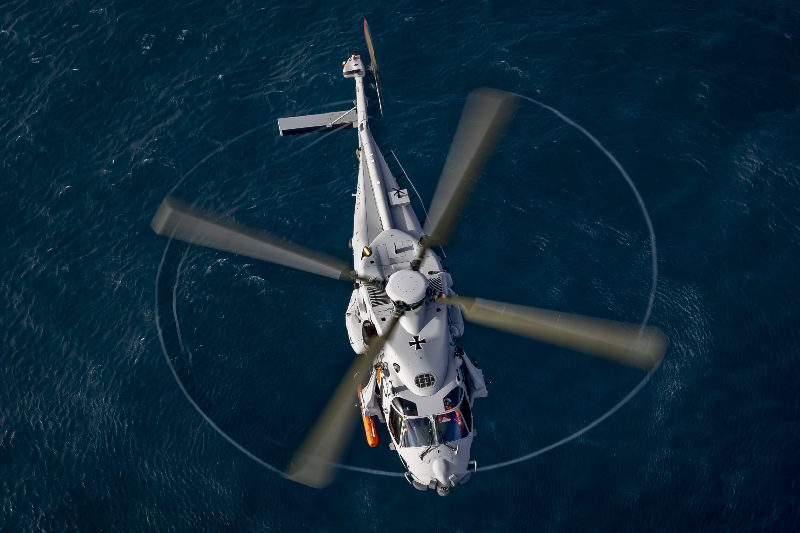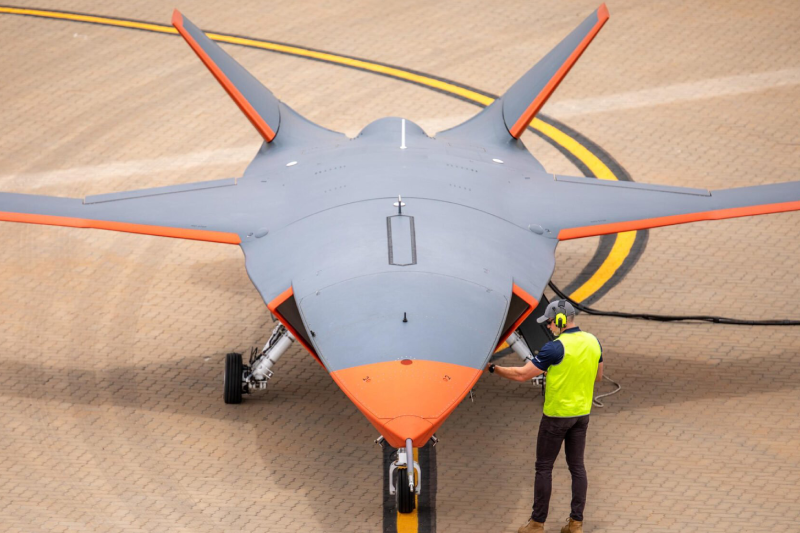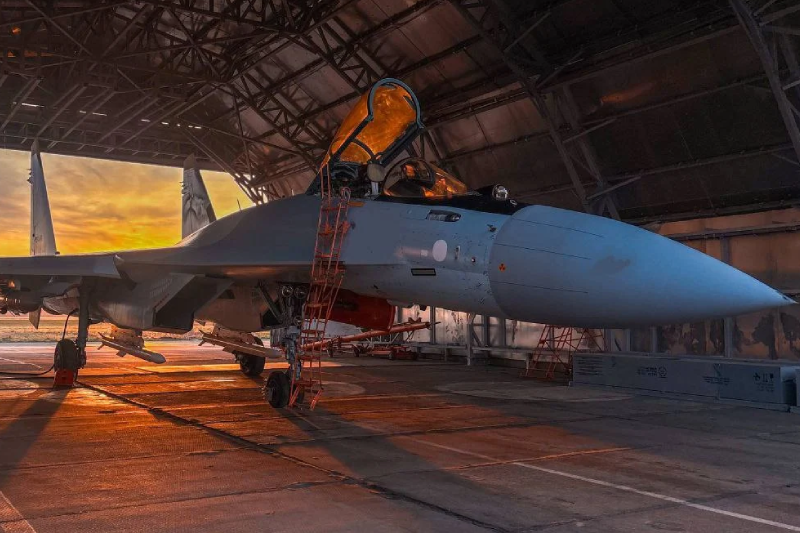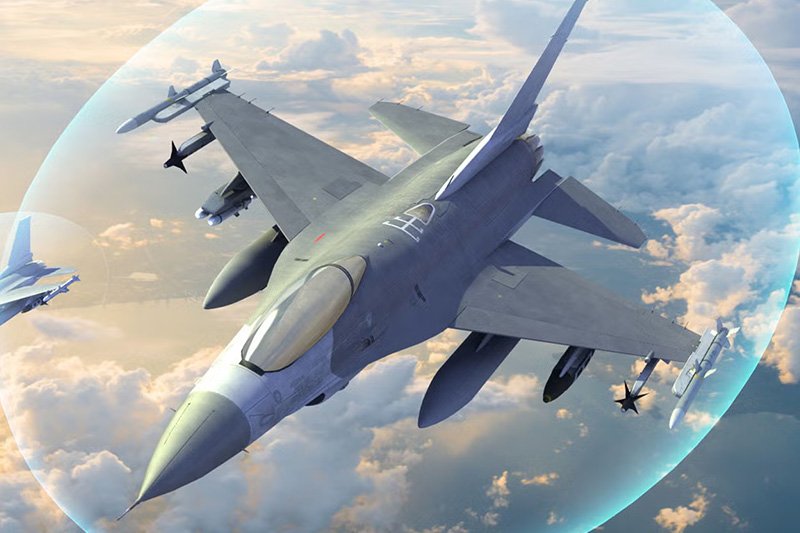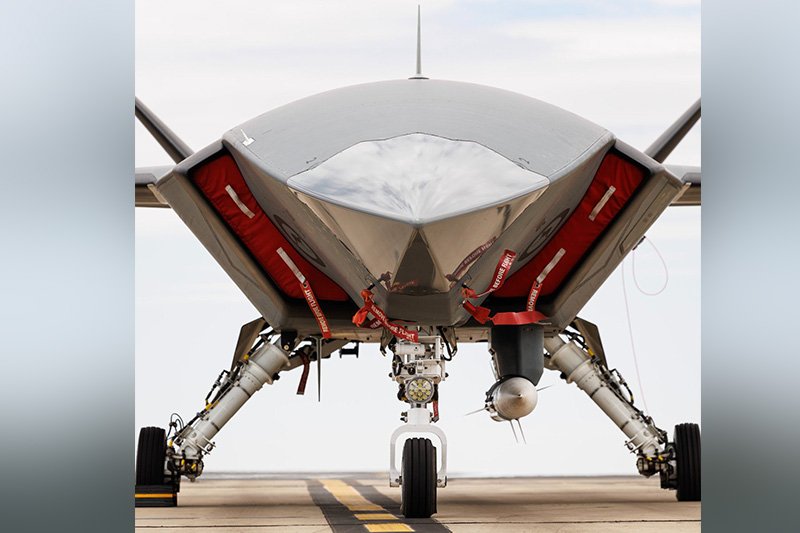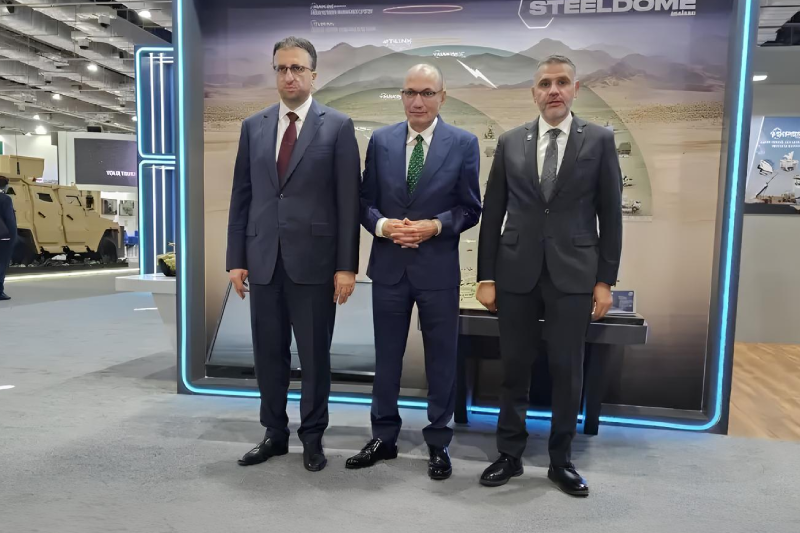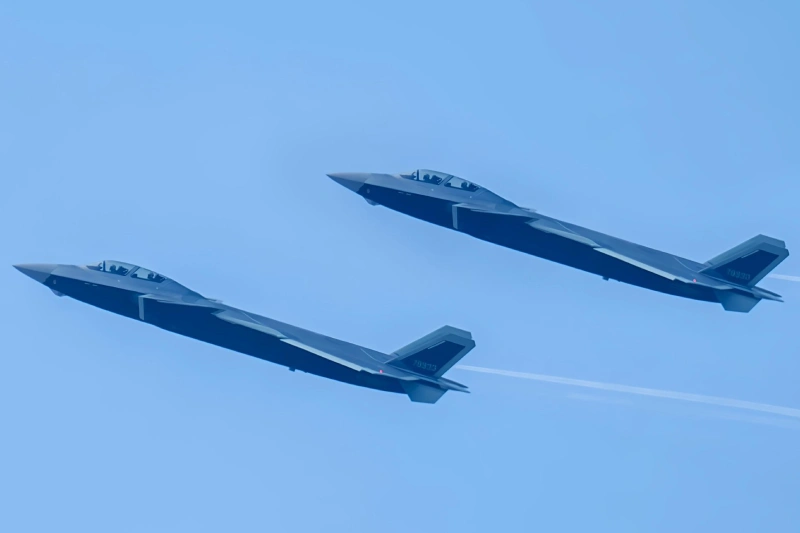China Deploys J-20S Dual-Seat Stealth Jet In PLAAF Operations
China’s fifth-generation stealth aircraft program has achieved a groundbreaking milestone that has captured the attention of defense analysts worldwide. Another variant, the twin-seat model of the J-20 stealth fighter, designated unofficially as the J-20S and J-20A sometimes as J-20B or J-20AS has been seen in flight formation with a J-20A aircraft under the same military parade preparations.
This aircraft represents a historic first in military aviation: the world’s first tandem-seat stealth fighter. Its appearance signals not only China’s expanding stealth fleet capabilities but also the introduction of entirely new operational concepts that could reshape modern air combat doctrine.
The J-20S: Engineering Marvel of the Mighty Dragon
The J-20S is based on the successful airframe of the J-20A with many changes being made to suit its operation with dual crew members. The most obvious transformation is the elongated canopy that has been made to accommodate 2 pilots in tandem formation. Nonetheless, this is an extra seat that can go way beyond training purposes.
The second crew member acts as a mission systems officer that allows the aircraft to fly complex operating profiles that are ineffective with single-seat variants. These are augmented functionalities of the electronic warfare operations, strike coordination, long range engagement planning, and real time control of the unmanned combat aerial vehicles.
Development and testing of this tandem-seat version has been ongoing for several years, but recent high-resolution imagery suggests the aircraft has now entered operational service within the People’s Liberation Army Air Force. There are high chances of induction into operations considering the systematic appearances of the J-20S airplane flying in tandem or in organized formations with the single-seat J-20A.
Revolutionary Operational Capabilities
The expanded role capabilities of the J-20S represent a significant evolution in China’s airpower doctrine. Through integration of a mission systems officer into a stealth platform, the J-20S will be able to serve as battle network node, directing both offensive and defensive air mission as it withstands being inside the contested airspace.
Such a structure renders the aircraft especially capable of performing manned-unmanned teaming operations, which will be an important aspect of future warfare concepts. The J-20S can effectively control loyal wingmen such as China’s FH-97A or other AI-enabled stealth drones currently in development, creating force multiplication effects that extend far beyond traditional fighter operations.
A capacity to operate many semi-autonomous or autonomous systems and still act stealth, offers a tactical flexibility never before possible. This would enable a commander to launch power over the long distances without incurring the risk to human pilots and achieve operational security due to the reduced electromagnetic signatures.
Engine Upgrades: Advanced Propulsion Systems
Among the features of J-20S development that are being watched really closely is the propulsion system. According to visual inspection of new images, the aircraft has a modified version of the WS-10 engine, presumably the WS-10C2 version of it. This monopropellant powerplant offers increased thrust, better fuel consumption and better thermal management.
The WS-10C2 engine capabilities are having great improvements in terms of performance compared to the previous ones in terms of supercruise performance and stealth performance by reduction of heat signature. These improvements are crucial for maintaining the aircraft’s low-observable characteristics during extended operations.
Nevertheless, there is a speculation of possible installment of the long awaited WS-15 engine. It is designed to fulfill all the requirements expected of a fifth-generation aircraft and provide considerably superior thrust-to-weight and supersonic cruising ranges than that of its predecessors, without incurring any afterburner usage.
If the J-20S is serving as a testbed for WS-15 technology, either in experimental configuration or early production form, it would represent a breakthrough for China’s entire military aviation industry. These two features combined would make it more complex, and able to travel farther with a much more increase in payload capacity and maneuverability would now be made possible by combining a twin seat capability combined with state of the art propulsion.
Advanced Sensor Technology: Next-Generation EOTS
The newest visuals of the J-20s show that it has had major improvements on its Electro-Optical Targeting System. The updated EOTS, mounted beneath the aircraft’s nose, displays a distinctive blueish appearance and improved structural design, indicating a substantial generational advancement in sensor capability.
It is said that this new EOTS will now give view in all directions (360-degree situational awareness) marking a radical breakthrough over the older generations of sensors. The system’s full spherical optical coverage enables the aircraft to detect, track, and engage multiple air and ground targets from all directions without relying on active radar emissions.
This capability of active tracking becomes very important in a stealth engagement situation because the J-20S can operate in stealthy modes being undetected and still authoritative ground truth battlespace. The system’s ability to provide continuous monitoring without compromising the aircraft’s low-observable characteristics offers significant tactical advantages.
The realization of the advanced sensor package means that J-20S is not merely a fighter aircraft, but an airborne sensor fusion node that can be networked with the airborne early warning systems, ground-based high command centers, and other stealth platforms via secure datalinks.
Strategic Doctrine and Combat Philosophy Evolution
The launch of the J-20S indicator is a paradigm change in the philosophy of the development of the fifth generation fighter. Most modern air forces have emphasized the aircraft with single-seat design such as the F-22 Raptor and F-35 Lightning II due to their minimal radar cross section and maneuverability, yet China took a different direction.
The dual-crew format helps to cover the growing complexity of today warfare conditions where decisions have to be taken within milliseconds and data being processed should cover various sources concurrently. The second crew member facilitates the separation of duties as it leads to the better management of the AI system, additional planning of the mission, the quicker evaluation of the threat, and the direct control of the UAV.
This approach aligns with China’s broader strategic framework, which emphasizes joint, networked, and high-speed operations over static platform superiority. J-20S is also an essential weapon to the process of creating air domination but with the ability to control and coordinate the overall ecosystem in air combat, instead of focusing strictly on stealth.
Airborne Command and Control Capabilities
Due to its ability to conduct a limited range of missions, the J-20S could be converted into the role of a flying tactical commander, arranging multiple fighters, drones, and even long-range missile strikes, in forward positions deep into enemy airspace. This is a huge step in air war where each platform is a node on a bigger grid.
A combination of a mission systems officer, advanced sensors, and the avionics based on artificial intelligence make the aircraft autonomous or semi-autonomous air-leaders on hundreds of kilometers of contested territory. The resultant long reach and co-ordination ability give a level of flexibility of operations never previously available.
Availability of integrated high-density communicational systems enables J-20S to access secure connectivity to various platforms and also keep the stealth features. It is during such a balance of connectivity and survivability that modern military aviation has achieved a great engineering work.
Parade Rehearsals and Public Debut Expectations
The fact that J-20S is visible during the practice of military parades seems to be strategic. These observations occur just weeks ahead of China’s planned military parade on September 3rd, commemorating the 80th anniversary of its World War II victory.
The fact that J-20A and J-20S aircrafts were practicing formation flights as a part of reorientation process signifies strongly that China is planning to demonstrate to the world, it has a complete package of its fifth-generation products. The integration of single seaters and twin seat configurations among these rotations alludes to the inference of operational use and not the mere presentation of exhibition sovereignty.
There have also been simultaneous images of J-35, the carrier-based stealth jet and J-20A and J-20S releases, military observers noted. This coordinated information release suggests a comprehensive strategic messaging campaign designed to display China’s land- and sea-based fifth-generation power projection capabilities.
International Context and Global Response
The design of J-20S is taking place in the competitive international landscape where key powers are seeking ways of strengthening their fighting capabilities in the air every time. China’s achievement in fielding the world’s first twin-seat stealth fighter demonstrates significant technological advancement and industrial capacity.
This development will likely influence other nations’ fighter development programs, as the advantages of dual-crew stealth operations become apparent. J-20S can introduce novel operating concepts that will have to be treated by other air forces in their respective modernization efforts.
The aircraft’s advanced capabilities also have strategic deterrence value, as potential adversaries must now account for enhanced Chinese airborne command and control capabilities when planning their own military operations.
Manufacturing and Production Considerations
The successful development of the J-20S demonstrates China’s advancing aerospace manufacturing capabilities. The capacity to produce a twin-seat version will entail great adjustment in the current production lines and quality control procedures demonstrating the mature industrial capacity.
It is quite possible to produce both single seat and twin seat models simultaneously and this capability implies effective planning, budgeting and sourcing of production. These adaptability in the mode of production offers strategic superiorities in covering various operation demands.
The decision to combine powerful sensors, propulsion, and avionics systems into the upgraded frame points to advanced system engineering abilities in short supply to other countries. This technical achievement reinforces China’s position as a major aerospace power.
Future Development Prospects
The J-20S represents the beginning of potential family expansion for China’s premier stealth fighter. The effective adoption of the dual crew capabilities creates an opportunity to further introduce the special variants of the aircraft that fits in a certain mission.
Potential future evolution will be electronic warfare-specific versions, command and control (C&C) or strike-specific versions. The modular approach to J-20 development suggests that China has planned for such expansion from the program’s inception.
The experience gained through J-20S development will likely inform future aircraft programs, creating technological spillover effects that benefit China’s entire aerospace industry. This body of knowledge is then a basis of further development of new generation aircraft.
Technological Achievements and Innovation
The J-20S development demonstrates China’s ability to innovate beyond simple technology adoption. Although the twin-seat layout is based on the world ideas of stealth fighters, this approach is original in terms of thinking in the context of future air combat.
The seamless positioning of highly sophisticated sensor systems, propulsion and crew coordination facilities onto a stealth platform entails a high degree of engineering answers. These achievements indicate China’s growing confidence in its aerospace design and manufacturing capabilities.
The aircraft’s development also showcases China’s ability to manage complex, multi-year military programs while maintaining operational security. The fact that the release of the information about the J- 20S is controlled indicates the presence of mature program management practices.
Training and Operational Integration
To deploy the J-20S successfully, it is a must that profound training be performedto both pilots and mission systems officers. The stealth missions required with dual-crew are complex, thus necessitating a lot of preparation and training in terms of coordination.
The training programs have to include elements of operating aircraft; it is also necessary to account on the requirements of coordination with unmanned systems, sensor control, and operating the network. This comprehensive approach ensures that crews can effectively utilize the platform’s advanced capabilities.
Incorporation of J-20S aircraft in the war air force should be well-planned so that the benefits of these novel capabilities can be fully realised without compromising their usefulness in operation. This is done through tactical development, training on maintenance and adaptation of the support system.
Economic and Industrial Benefits
The J-20S program also enjoys immense economic gain in form of advanced manufacturing demands, trained workforce, and innovation technology. These effects extend beyond military applications to benefit China’s broader aerospace industry.
The program’s success enhances China’s position in international defense markets, potentially creating export opportunities for related technologies and systems. This commercial potential gives extra payoffs to research and development investments.
The technological expertise developed through the J-20S program contributes to China’s overall industrial capability, creating knowledge that can be applied to civilian aerospace projects and other high-technology sectors.
Also read this: China Feitian 2 Hypersonic Vehicle Passes Critical Test Flight
Reshaping Modern Air Combat
The development of the J-20S is not merely a technological gain; the development of the PLA Air Force; it is doctrinal message of what air war will be. China is manifesting how stealth fighters will be used in combat systems of the future, where the focus is more on coordination and control, instead of individual platforms superiority.
The world’s first twin-seat stealth fighter combines advanced stealth characteristics with sensor fusion, multi-crew capabilities, and potentially next-generation propulsion systems. When this combination becomes complete the traditional air superiority fighter becomes a strategic aerial command post creating a platform with an ability to coordinate complex operations.
Whether deployed for deep strike missions, drone coordination, or electronic warfare, the J-20S confirms that China’s Mighty Dragon continues evolving into a family of variants capable of dominating future aerial battlefields. As the balance of airpower in the world is shifted further, the J-20S might become one of the most impactful aircraft projects of the decade.
The aircraft’s successful development and apparent operational integration demonstrate China’s growing aerospace capabilities and strategic vision. With the J-20S gearing up to its potential first public appearances, it exists as the manifestation of years of work as well as a springboard toward the future of military aviation development.
Keep connected with us at Facebook, Twitter, YouTube, Instagram & TikTok for latest defense happening around the globe.
Discover more from International Defence Analysis
Subscribe to get the latest posts sent to your email.


